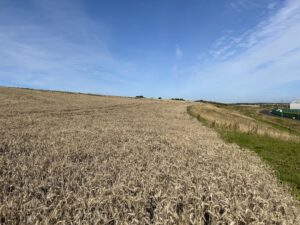Solar farm symbolises transition from old to new
KEY FACTS
In a recent commission, Motion provided transport planning and infrastructure design engineering advice to clean energy technology company, Enviromena, whose proposals to build a solar farm in Seaham, County Durham, will transform an area historically associated with coal mining. The successful application for the 8.5MWp Fox Cover solar farm will not only help drive the UK’s transition towards a decarbonised energy system. The scheme also delivers ecological benefits including biodiversity net gains of 213% in habitat units and 192% in hedgerow units. Societal gains are high on Enviromena’s agenda and the company is working closely with the local planning authority to fund community projects.
Renewables Project Developer, Jamie Clouston, says, “This outcome was the result of an effective collaboration between Enviromena and our team of consultants, pre and post submission. With the planning approved in the first week of January, it has set the precedent and tone for the rest of the year.”
Jamie explains, “Whilst larger solar farms form the foundation of the UK’s decarbonisation strategy, smaller solar farms like Fox Cover play an important role in grid flexibility and resilience in locations where faster deployment is required. The Fox Cover solar development shows that schemes of all sizes are being consented during NESO’s grid connections reform.” He continues, “Being located close to former collieries, the site is also symbolic of the move from old to new energy technology.”
Site constraints
Despite the positive outcome, Motion had to overcome the site’s difficult topography when assessing the best access route. The team also needed to respond quickly to changing requirements arising from the landowner’s evolving plans for adjacent land.
 Senior Transport Planner, Andrew Nock, takes up the story. “As is common with solar farm applications, HGV access presents an issue, if not a challenge. In this case, plans for a nearby EV charging facility and garden village needed to be taken into consideration when reviewing traffic impact and determining the most suitable route into the site.”
Senior Transport Planner, Andrew Nock, takes up the story. “As is common with solar farm applications, HGV access presents an issue, if not a challenge. In this case, plans for a nearby EV charging facility and garden village needed to be taken into consideration when reviewing traffic impact and determining the most suitable route into the site.”
The original proposed southeastern route into the development initially appeared to provide the best access arrangement. However, the plans to build EV charging bays with a drive-thru coffee outlet to the east of the site would result in construction vehicles interacting with drive-thru traffic. An alternative route was identified to the northeast of the site but the large differences in ground levels on the approach road would be difficult for HGVs to navigate safely.
Challenging terrain
A southeast access would have been approached on a shallower gradient but two-way movements would have been difficult during the construction phase. According to Andrew Nock, “Low speed restrictions on Admiralty Way would help allay any concerns about visibility on the northeastern approach, and the road was already accommodating large vehicles.”
speed restrictions on Admiralty Way would help allay any concerns about visibility on the northeastern approach, and the road was already accommodating large vehicles.”
Motion’s infrastructure design team was commissioned to develop the site access that provided a balanced cut and fill to minimise the volume of earthworks required. The earthworks calculations and new access plans demonstrated that HGVs could follow the contours of the slope and manoeuvre safely and efficiently within the development, maximising the site’s capacity.
The provision of comprehensive and timely data and Soil Management Plan overcame one of the key objections from the local planning authority. Swept Path Analysis also helped the team to understand and mitigate any vehicular disruption during the construction phase.
Transport planning and engineering problem-solving
Jamie Clouston concludes, “The Motion team responded to each request for information in a timely manner, dealing with several changes within a short space of time and remaining flexible throughout the process. They helped us to understand the feasibility of each small revision to the site layout and successfully make the case for the northeastern access.”
He adds, “The strong relationship we have with Motion allowed for swift and decisive changes to the access strategy throughout the entire planning process. This collaborative problem-solving made the difference.”
Fox Cover Solar Farm project at a glance:
- 8.5MWp scheme will power more than 3,100 homes annually
- 1,700 tonnes of carbon saved per year
Motion contribution:
- Preparation of Transport Statement
- Swept Path Analysis for HGV access and turning manoeuvres
- Visibility Splay calculations for access
- Civil engineering support with cut and fill design for proposed new access route to address difference in levels
- Soil Management Plan
Eventual outcome:
- Biodiversity net gains of 213% in habitat units and 192% in hedgerow units
- Nearly 1km of new native hedgerow, 4,000 s m of woodland planting and 8 hectares of meadow grassland habitat
- Enables regional shift from fossil fuel mining to clean energy generation
- Support to deliver national transition to a decarbonised energy network
“The strong relationship we have with Motion allowed for swift and decisive changes to the access strategy throughout the entire planning process. This collaborative problem-solving made the difference.”
Jamie Clouston, Renewables Project Developer, Enviromena



